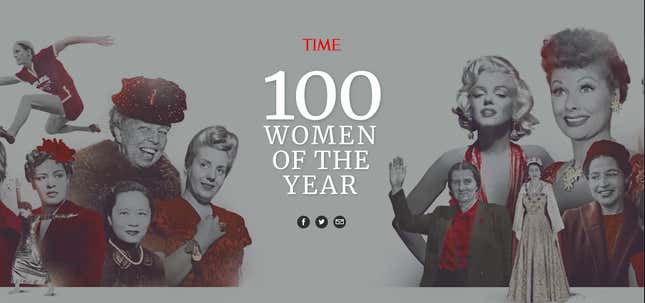
This year, in addition to choosing one man of the year, Time magazine has decided to gift us with a project called ‘100 Women of the Year’. (I know the title has technically been called ‘Person of the Year’ since 1999, but let’s be real, it’s mostly been given to men.) This project recognizes some of the brilliant and influential women of the last century whose stories haven’t been told within the pages of the magazine. Time even went as far as to create 89 new covers to go along with these stories (they kept the already existing 11 covers for the women who have received the title of ‘Person of the Year’ since 1999).
The project’s introductory essay breaks down the process that Time went through to select these women.
“With this 100 Women of the Year project, we’re spotlighting influential women who were often overshadowed. This includes women who occupied positions from which the men were often chosen, like world leaders Golda Meir and Corazon Aquino, but far more who found their influence through activism or culture.”
I appreciate that the team who selected these women deliberately didn’t limit their choices to women who were on the global political stage, as that excludes many black women and women of color whose impact is best measured using other metrics.
“As former TIME editor-in-chief Nancy Gibbs writes, this project is an exercise in looking at the ways in which women held power due to systemic inequality. ‘Women,’ Gibbs writes, ‘were wielding soft power long before the concept was defined.’”
While I can appreciate the effort by Time to right past wrongs, journalism is not just a passive force that reflects the priorities and values of a given time period or a given group of people, it is also an active authority that plays a role in influencing where we as a society focus our attention. In case you’ve forgotten, Time’s Person of the Year in 2016 was Donald Trump. (I’m sure they’re very proud of how well that choice aged.) Choosing someone to highlight as a “Person of the Year” is both a way of synthesizing the occurrences of the past year and also a means of uplifting a person or persons who the powers that be at Time believe will continue to influence our society and our world in the future. Let’s not forget here: objectivity is a myth, and journalists are never really removed from the stories we tell.
By choosing to give a person the title of Person of the Year, even when that title comes with a thoughtful critique, Time is validating the significance of that person’s impact, and contributing to the longevity of their legacy. While I appreciate the intent of Time’s ‘100 Women of the Year’ project, it is impossible to correct the damage done by nearly a century of naming men as the ‘Person of the Year’ in just one year. In order to really begin undoing the harm wrought by a century of overlooking the influence and contributions of these women and others like them, Time shouldn’t just write about women from the past—they should write about the ones doing the work today.
Correction 3/6/20, 10:27 am: The ‘100 Women of the Year’ project was created in addition to the ‘Person of the Year’ title, not instead of it, because why eliminate the option of giving the title to another man at the end of the year?